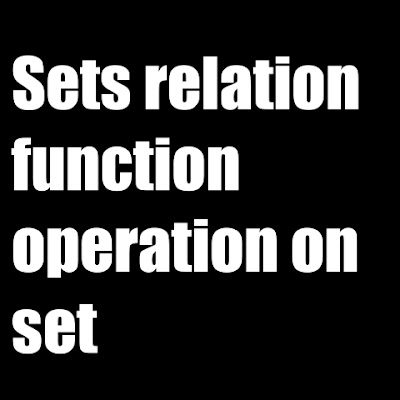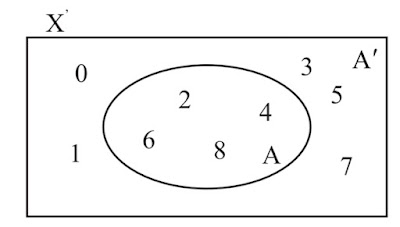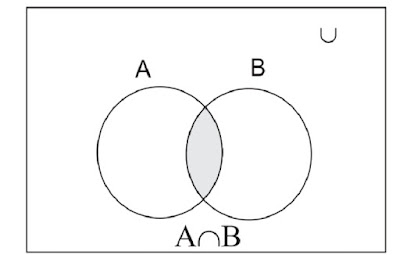Sets relation function operation on set
Operation ON SETS
1) Complement of a set:
The complement of the set A is denoted by
A' or Ac .It is defined as
A' = {x/x∈U, x∉A} = set of all elements in
U which are not in A.
Ex. Let X = {0, 1, 2, 3, 4, 5, 6, 7, 8} be the
Universal Set and A = {2, 4, 6, 8}
∴ The complement of the set A is
A' = {0, 1, 3, 5, 7}
Properties:
i) (A')' = A ii) φ' = U iii) U' = φ
2) Union of Sets:
The union of two sets A and B is the set of
all elements which are in A or in B, (here
'or' is taken in the inclusive sense) and is
denoted by A ∪ B
Thus, A ∪ B = {x/x∈A or x∈B}
The Union of two sets A and B i.e.
A ∪ B is represented by a shaded part in
Venn-diagram as in
Related Post :- Sets Relation and Function INTRODUCTION and Types of sets
Ex. A = {x/x is a prime number less than 10}
B= {x/x∈N, x is a factor of 8}
find A∪B.
Solution :
We have A = {2,3,5,7}
B = {1, 2, 4, 8}
∴ A∪B = {1, 2, 3, 4, 5, 7, 8}
Properties:
i) A ∪ B = B ∪ A (Commutativity)
ii) (A ∪ B) ∪ C = A ∪ (B ∪ C)
(Associativity)
iii) A ∪ φ = A Identity for union
iv) A ∪ A = A Idempotent law
v) If A∪ A' = U
vi) If A⊂B then A∪B = B
vii) U∪A = U
viii) A⊂(A∪B), B⊂(A∪B)
3) Intersection of sets:
The intersection of two sets A and B is the
set of all elements which are both in A and
B is denoted by A∩B
Thus, A ∩ B = {x/x∈A and x∈B}
The shaded portion in Fig. 5.5 represents
the intersection of A and B i.e. A∩B
Ex. A={1,3,5,7,9}
B = {1,2,3,4,5,6,7,8}
Find A∩B.
Solution: A∩B = {1,3,5,7}
Ex. (Activity) : If A = {x/x∈N, x is a factor of 12}
B = {x/x∈N, x is a factor of 18}
Find A∩B
Solution:
A={ 1, 2, 3, 4 , 6, 12}
B = { 1, 2, 3, 6, 9, 18}
∴ A∩B = { 1, 2, 3, 6}
= common factors of 12 & 18
Ex. : A = {1,3,5,7,9}
B = {2,4,6,8, 10}, A∩B = ?
Solution :
∴ A∩B = { } = φ
If A∩B = φ, A and B are disjoint sets
Properties:
i) A∩B = B ∩A (Commutativity)
ii) (A ∩ B) ∩ C = A ∩ (B ∩ C)
(Associativity)
iii) φ∩ A = φ
iv) A ∩ A = A Idempotent law
v) A∩ A = ∅
vi) if A⊂B then A∩B =A
vii) U∩A = A (Identity for intersection)
viii) (A∩B) ⊂A, (A∩B) ⊂B
ix) a) A∩(B∪C) = (A∩B)∪ (A∩C)
b) A∪(B∩C) = (A∪B) ∩ (A∪C)
..... Distributivity
De Morgan's Laws:
For any two sets A and B
1) (A∪B)' = (A'∩B')
2) (A∩B)' = (A'∪B')
4) Difference of Sets:
Difference of set A and set B is the set of
elements which are in A but not in B and is
denoted by A-B, or A∩B'
The shaded portion in represents
A-B. Thus, A-B = {x/x∈A, x∉B}
Similary B-A = {y/y∈B, y∉A}
Note:
i) A-B ⊆ A and B-A ⊆ B.
ii) The sets A-B, A∩B and B-A are mutually
disjoint sets, i.e. the intersection of any of
these two sets is the null (empty) set.
iii) A-B = A∩B' , B-A = A'∩B
iv) A∪B = (A-B)∪(A∩B) ∪ (B-A)
v) (A-B) ∪ (B-A) = A∆B is called symmetric
difference of sets A and B
 |
| Sets relation function operation on set |











